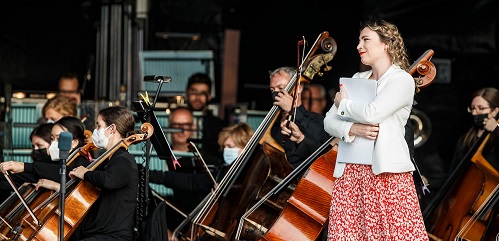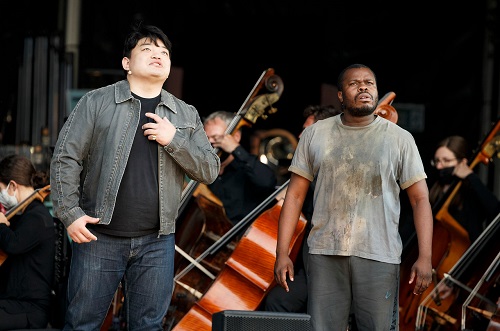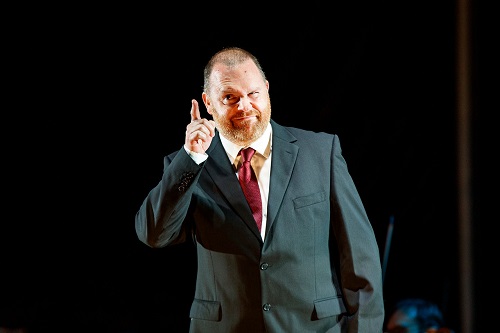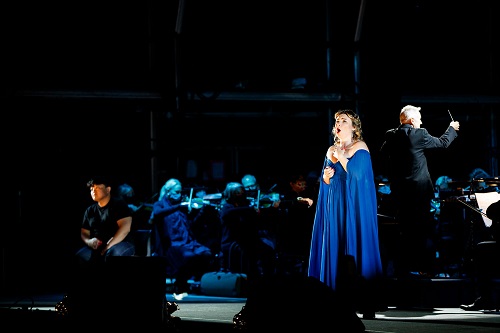English National Opera seem to be making a summer habit of popping up with Puccini in London’s palace-parks. After 2020’s hill-top drive-in La bohème at Alexandra Palace, this year the company have ventured to the city’s southern suburbs to present two performances of Tosca at the South Facing Festival in Crystal Palace Bowl.
With its covered stage ‘floating’ on the lake, and grassy slopes accommodating the audience across the water – some seated, most reclining on picnic rugs – the Bowl has the potential for magic. A sun-deprived August, a stiff northerly and some strict entrance rules could easily put the damper on things. No food and drink can be brought into the Bowl, but you can buy burgers, pizzas and beer – if the Bar isn’t low on stocks – inside. Rather different to those country house operas where bring-your-own picnicking is positively encouraged.

Both the cast and the orchestra nestled behind the singers’ apron stage were miked. Fair enough, it’s an outdoor venue; but, it’s not that big a space, and the volume-testers had evidently been over-enthusiastic. The booming amplification sabotaged the singer’s diction – only Roland Wood (Scarpia) was consistently audible, though things improved in the more sparsely scored episodes of Acts 2 and 3. In any case, Tosca’s libretto doesn’t share Figaro’s unfathomable convolutions (though it does have some of its non-sequiturs). There were no surtitles though (nor programme or synopsis of the kind one might expect inside an opera house), and the lack of audible text might seem to undermine one chief reason for singing in English – and add a hurdle for those opera-newcomers whom you’re hoping to hook into your home theatre next season. During the intervals the two video screens on either side of the stage advertised ENO’s wares, accompanied by a sound-bite soundtrack.
On the whole, the sound system behaved itself, but the output seemed to suffer from the multi-genre nature of the Festival, which made a one-size-fits-all compromise necessary. Bass was favoured over treble: Scarpia’s darkness seemed even more predominant than usual. When the cellos and double basses had vigorous pizzicato passages, my bones shook. The prevailing thunderous reverberations had a distancing effect, exacerbating the not inconsiderable gap between us and them, and disengaging the singers’ resounding voices from the action we watched playing out on the two giant screens.

The camera work was generally good, with perspectives varied and close-ups judiciously employed. At one point, I wondered whether a free film screening of an ENO production in the Park might have been a better option. Donna Stirrup was credited as Director but, not surprisingly and understandably, ‘staging’ was minimal in this modern-dress performance, with just a few props to indicate setting and scene. Some thought might have been given to the stage lighting, though; there was initially little illumination of the apron and the characters, dressed predominantly in black or dark grey suits, were hard to pick out against the ENO Orchestra seated behind them, making it difficult to ‘tune in’ to the drama initially. Only Natalya Romaniw, dressed vibrantly in, first, smart pink and white, and then glamorous ultramarine, stood out. Perhaps that was the intention. As night fell, though, the blue-lit auditorium shimmered against the night sky and the action grew progressively more focused.

That the performance itself was so enjoyable – and at times transfixing – attests to the singers’ gifts, generosity and commitment. David Junghoon Kim was a persuasive Cavaradossi, sensitive but impassioned. Confident and clear-toned from the first, the tenor didn’t flag and wasn’t timid in shaping both the climactic and poignant moments thoughtfully. It was unfortunate that in his anguished lament, ‘E lucevan le stelle’, the clarinet countermelody was amped up to sound like a jazz saxophone.
Roland Wood’s Scarpia was a truly nasty-piece-of-work, the baritone’s menacing voice dominating even the full-throated ENO Chorus in the Te Deum – though the Chorus suffered especially from the muddying sound-system. But, Wood’s Scarpia was not a one-dimensional thug: there was a deceptive eloquence at the start of Act 2, as he mused on Cavadarossi’s imminent downfall; and a devious smoothness in his subsequent callous tormenting of Tosca, the violence barely suppressed, imbuing the scene with a calculating mercilessness.

In the title role, Natalya Romaniw was a complete star. This Tosca was tempestuous and fierce, driven by extremes of passion and envy, vengeance and despair, but Romaniw made such emotions feel so human and real, overcoming the practical obstacles and capturing the audience’s eyes, ears and hearts. During Scarpia’s Act 2 manipulations, I found myself truly drawn into the drama, forgetting the chilly breeze, the boomy sound and the fact that I was essentially watching a film-screen rather than an operatic stage. It was all the more remarkable as Romaniw, bare-shouldered in a beautiful blue gown, must have been frozen! As the wind whipped up off the water, no wonder she hugged her arms tightly around herself during Scarpia’s torturous onslaught. ‘Vissi d’arte’ held the moment entirely: there was not a shuffle or whisper from the captivated audience – and no doubt the birds and beasts in the Park were entranced too.
Simon Shibambu’s bass-baritone conveyed every ounce of Angelotti’s pride and conviction, while David Ireland was an engaging Sacristan. Basses William Thomas as Sciarrone and Colin Judson as Spoletta completed the cast. Conductor Richard Farnes seemed to be enjoying himself despite the fact that every delicate detail he coaxed or urgent crest he conjured was relayed with clamorous unsubtlety.
Crystal Palace may not have the imposing splendour of the Palazzo Farnese, and the Bowl is not the Castel Sant’Angelo, but though I arrived somewhat sceptical, I left the Festival site a little shivery but satisfied. I hope that some of the undoubtedly happy punters around me find their way to the Coliseum in the coming season.
Claire Seymour
Tosca – Natalya Romaniw, Cavaradossi – David Junghoon Kim, Scarpia – Roland Wood, Sciarrone –William Thomas, Spoletta – Colin Judson, Sacristan – David Ireland, Angelotti – Simon Shibambu; Director – Donna Stirrup, Conductor – Richard Farnes, English National Opera Orchestra and Chorus.
Crystal Palace Bowl, London; Sunday 29th August 2021.